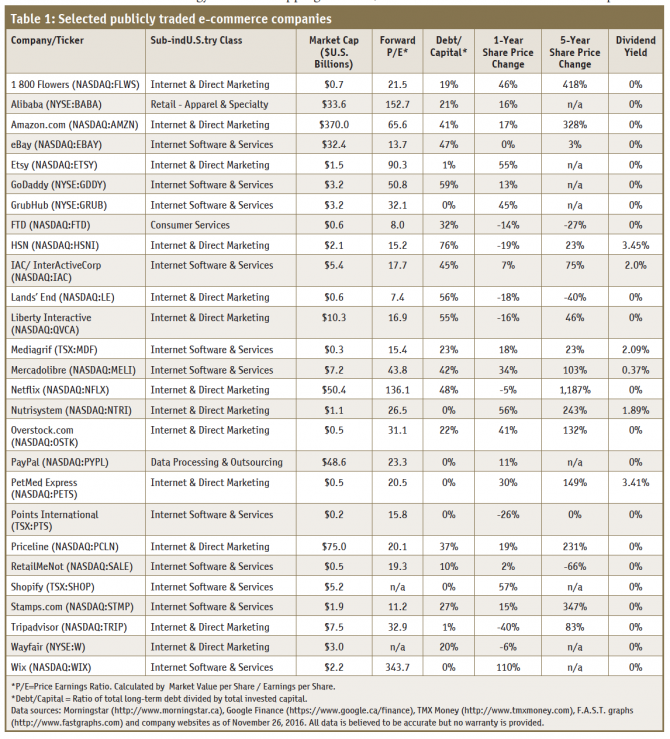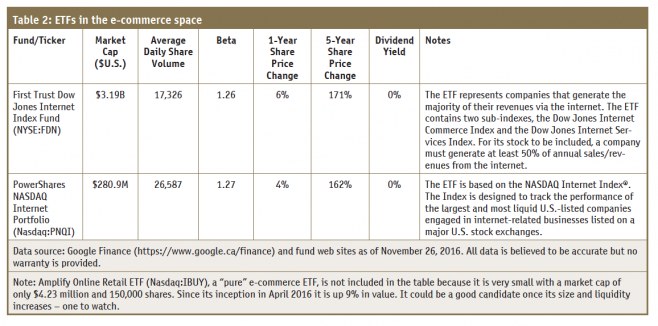E-Commerce
The Trend
E-commerce, or the retail sales of goods and services to consumers using the internet, is a secular trend1 that’s been in the making since the internet went fully commercial circa 1995.
Some Facts
It is hard to find another area of the economy that is growing as fast as e-commerce.
In 2016, total retail sales (off-line and online) are forecast to be about $22 trillion globally, with e-commerce making up 8.7%, or $1.9 trillion. Worldwide retail e-commerce sales are forecast to increase to $4 trillion by 2020, making up 14.6% of total retail spending that year (a 68% increase in four years). The Asia-Pacific region is the world’s largest retail e-commerce market with sales expected to exceed $1 trillion in 2016 and more than double to $2.725 trillion by 2020. North America’s e-commerce sales are estimated at $423 billion and are projected to grow by double digits to 2020.2
Canadian e-commerce sales are anticipated to reach $39.9 billion by 2019, or 9.5% of total retail transactions.3
Forty percent of worldwide internet users have purchased products online via desktop, mobile, tablet or other online devices. That’s more than 1 billion online buyers.4 The average online consumer worldwide spends $1,630 per year.5
November 2016’s “Single’s Day” event in China generated a record $17.6 billion in e-commerce sales in 24 hours on the Alibaba platform.6
U.S. e-commerce sales broke new records in 2016 as well. Over Thanksgiving and Black Friday, $5 billion was spent online, an 18% percent increase year-over-year. 7 Cyber Monday came in with a U.S. single-day record clocking $3.4 billion in online sales8. Online sales in November and December 2016 in the US rose by 11% to a record $91.7 billion.9
In the U.S., 51% of Americans reportedly prefer to shop online rather than in stores—a figure that jumps to 67% for Millennials and 56% for Gen Xers.10
Online shopping offers low prices, fast or instantaneous fulfillment, and the ability to research and compare products before buying. Popular purchases include electronics, apparel, books, travel, event and restaurant bookings along with digital products and services like software, streaming audio and video, games and gambling.
Future opportunities include borderless retail and multi-channel retail (integrating online activity with in-store sales).11 Advances are being made with artificial intelligence helping online shoppers, payment systems and the use of services like Uber to deliver goods.
A multitude of companies are embracing e-commerce. They include “pure play” companies, traditional brick and mortar retailers that are becoming “bricks and clicks” and shipping, delivery and industrial warehouse firms providing the “picks and axes.”
It can’t be denied that e-commerce is disruptive for traditional retailers. Last summer, Wal-Mart agreed to buy Jet.com, an online wholesaler, for about $3 billion, reportedly the largest e-commerce deal in history.12 Hudson’s Bay recently invested $60 million to ensure it can process online orders “out the door” within 15 minutes from its automated warehouse and fulfillment center.13
Privately held Airbnb is disrupting the hotel industry. The $30 billion San Francisco-based online home and apartment rental juggernaut’s website lists 2.3 million properties in 57,000 cities and 191 countries representing 500,000 nightly stays, for a total of over 80 million guest arrivals.14 This is one to watch as it almost single-handedly delivers a disruptive blow to the traditional hotel industry.
A growing number of Canadian e-commerce companies are innovating in areas like merchant infrastructure, payment platforms, retail optimization and enhancement and technology-enabled shopping experiences. Most of these companies are privately held so are not directly investable right now by retail investors. It is notable they have raised about $1 billion in private equity since 2010.15
Risks
There are risks associated with investing in the e-commerce trend. Aside from standard investment risks,16 one must consider that e-commerce spans both the retail and technology sectors. This means economic conditions affecting both these sectors must be kept in mind.
Valuations of many of the companies participating in the e-commerce space can be extremely high, reminiscent of the “dot-com bubble.” This is a result of both high growth expectations and companies trying to dominate their chosen market niche before attempting to make meaningful profits. Needless to say: buyer beware!
Ideas for Further Research
There are many investment candidates in the e-commerce space. Table 1 lists some of many publicly-listed companies.
There are surprisingly few ETFs available to pursue an investment in the e-commerce space. Two that include businesses deriving much of their revenues over the internet are shown in Table 2. (For even more equity investment ideas research the holdings in these ETFs.)

How to Invest In The E-commerce Trend
Clearly there are lots of choices for investors. The “safest” investment is probably through an ETF to spread risk across a number of companies. Either one of the two ETFs above could be a good option given their size, daily share volumes and historical share price histories. FDN is slightly cheaper with a 0.54% expense ratio while PNQI is at 0.60%. These ETFs allow the investor to play the field without taking on too much single company risk.
The e-commerce companies with big brand names like PayPal, eBay and Alibaba have broad consumer recognition, which is an advantage in a domain where growth and market-share are vital, but the sheer size and breadth of Amazon’s operations makes it stand out from the pack.
Amazon is not only huge it is extremely innovative. It has online sales at its core, but is now testing revolutionary, if unproven, new physical stores that leverage mobile devices to avoid checkouts and associated line ups.17 It is also expanding very rapidly in fulfillment services, streaming audio and video and cloud computing among many other ventures. Its valuation is as lofty as its CEO Jeff Bezos is visionary. Yet its management, name brand, financial might, market dominance and apparent agility in spite of its size, combined with its long-term performance through the dot-com bubble and the financial crisis, makes it hard to believe it will not continue to succeed.
In Canada, one might wish to consider Shopify’s prospects. It is creating an ecosystem of software, apps and web site designs that help small and medium (and sometimes large) businesses get their e-commerce, brick and mortar, and mobile sites all working in tandem. As an early growth company without profits and a high valuation, it is risky. It could well leverage CEO Tobias Lütke’s vision and complimentary relationship with Amazon (the latter has vacated the online store field in favour of Shopify) into becoming a very sizable player. Revenue growth has been stellar so far since its initial public offering last year (at ~$130M in its last quarter). It is making great strides in mobile e-commerce which should bode well for the future.18
Although Wal-Mart is not listed in the table above (it is not at core an e-commerce company, at least not yet) it remains interesting. It is making a big bet on e-commerce and indications are that its online sales are growing considerably faster than its off-line sales, notwithstanding some hiccups along the way. It sells about one-sixth as much online as Amazon does, at $14B per year, but those sales are starting to grow fairly rapidly.19 With its purchase of Jet.com, Wal-Mart’s online presence should grow even faster. As a bonus, Wal-Mart pays a 2.86% dividend, has a much lower P/E ratio (about 16) than most “pure plays” and fared better than most businesses during the financial crisis. This could be a good value play.

Concluding Remarks
E-commerce is having a big impact on the global economy. It is de-stabilizing traditional retail while creating wealth in whole new ways. There are many potential investment opportunities in the e-commerce space but risks can be very high. Nevertheless, e-commerce is a rapidly growing secular trend that isn’t going away anytime soon.
Michael Patenaude, BA, MA, is an avid personal finance enthusiast living in Ottawa. He has partnered with Peter McMurtry, BCom, CFA, to create the McMurtry Investment Report™, an online newsletter and blog featuring strategies for do-it-yourself investors (mcmurtryinvestmentreport.ca). He is also the founder of two other web sites: money4retirement.ca which publishes his own blog and portfolio along with content from the Ottawa Share Club; and ItsMyPortfolio.ca which features an annotated directory of over 300 investment resources for independent Canadian investors. Email: mrpatenaude@gmail.com. Disclosure: Michael owns shares in Shopify.
- An investment trend associated with some characteristic or phenomenon that is not cyclical or seasonal but exists over a relatively long period. Adapted from: http://www.bU.S.inessdictionary.com/definition/secular-trend.html
- https://www.emarketer.com/Article/Worldwide-Retail-E-commerce-Sales-Will-Reach-1915-Trillion-This-Year/1014369
- http://www.theglobeandmail.com/globe-investor/advisers-view/investing-in-e-commerce-more-complex-than-it-looks/article32620949/
- https://www.statista.com/markets/413/e-commerce/
- https://www.statista.com/topics/871/online-shopping/
- http://www.dnaindia.com/money/report-alibaba-rakes-up-U.S.-176-billion-on-singles-day-sales-sets-new-global-record-2272700
- https://techvibes.com/2016/11/28/black-friday-breaks-ecommerce-record
- http://marketingland.com/report-cyber-monday-largest-e-commerce-day-history-199368
- https://www.emarketer.com/Article/Holiday-Sales-Trends-Heighten-Brick-and-Mortar-Woes/1014990
10.http://10ecommercetrends.com
11.https://www.atkearney.com/consumer-products-retail/e-commerce-index/full-report/-/asset_publisher/87xbENNHPZ3D/content/global-retail-e-commerce-keeps-on-clicking/10192?_101_INSTANCE_87xbENNHPZ3D_redirect=%2Fconsumer-products-retail%2Fe-commerce-index
12.http://www.bU.S.inessinsider.com/Wal-Mart-earnings-beat-as-e-commerce-grows-2016-11
13.http://www.cbc.ca/news/bU.S.iness/bay-amazon-e-commerce-1.3840258
14.http://expandedramblings.com/index.php/airbnb-statistics/
15.http://www.canadianbU.S.iness.com/innovation/canada-ecommerce-innovators/
16.http://www.getsmarteraboutmoney.ca/en/managing-your-money/planning/investing-basics/Pages/Types-of-investment-risk.aspx#.WDslPXeZP-Y
17.https://www.bloomberg.com/news/articles/2016-12-05/amazon-opening-store-that-will-eliminate-checkout-and-lines


